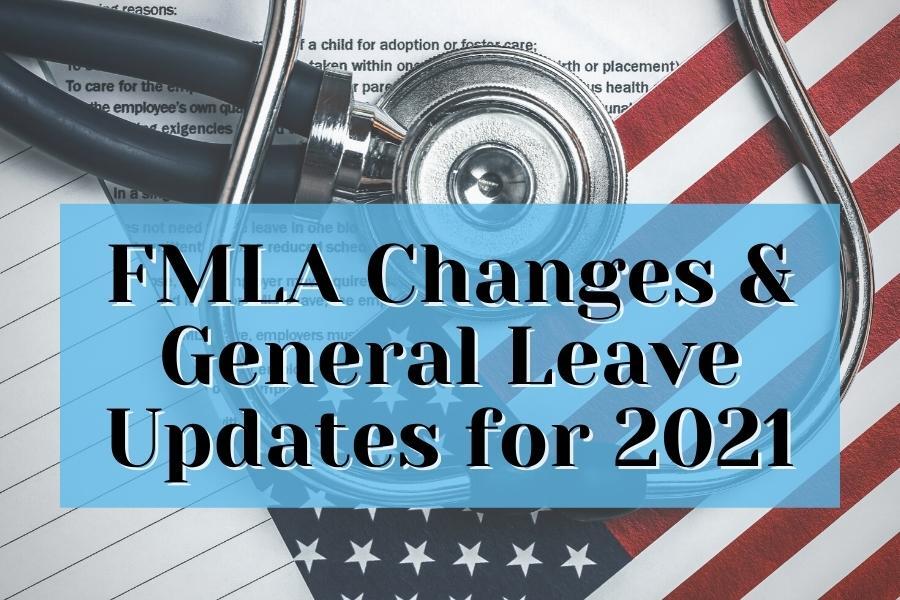Get in touch
408-366-8880
mymail@mailservice.com

FMLA Changes & General Leave Updates for 2021
Everyone worldwide has experienced some degree of tumult since early 2020, when COVID-19 reached pandemic status. Workers all over the world have had to adjust to remote work options and many other unprecedented work-related modifications.
One thing that hasn’t changed in the past two years is that family medical issues that require valued employees’ attention come up. Sometimes, a situation requires their physical presence to manage the matter, which is frequently upsetting and worrisome for the family for some duration.
As most people know, such matters didn’t decrease with the onset of the Coronavirus pandemic. On the contrary, issues worsened, or new concerns specific to the novel virus itself arose in many cases. With that, the Department of Labor (DOL) had to take a fresh look at a classic law and make it work in the general sense and according to matters regarding COVID-19.
Do you know everything you need to know about Family Medical Leave Act (FMLA or Act) changes and general leave updates? If you’re uncertain, our KBI benefits team keeps up with all the latest FMLA changes and more, so let’s see what’s happening.
FMLA BASICS TO REVIEW
Before exploring and discussing any recent FMLA changes, let’s take a look at the basic tenets and goals of the FMLA. Enacted in 1993, the FMLA has served as the cornerstone and face of the DOL’s efforts to create, foster, and promote work-life balance for employees who want to care for their families.
It’s easy to see the lingering fruits of the Act since such work-life balance values have become ingrained in the modern workplace, ensuring that workers never need to choose between their own livelihood and being there for those they love.
The FMLA was a welcome relief for working generations like the Silents, Boomers, and Generation X at the time, offering respite for those choosing to start a family or take care of aging or ill loved ones. Nearly 30 years later, Millennials and Generation Z entered the workforce, having never known a time without the FMLA enacted. These generations have grown up watching their parents have the ability to use the FMLA in times of trouble and living in a world that increasingly values work-life balance, rather than working themselves into a state of stress and one wherein they have to choose a career over parenthood.
According to the DOL, the FMLA has been used more than 100 million times to “help workers balance the demands of the workplace with the needs of their families and their own health.”
BASIC FMLA COVERAGE CONSIDERATIONS
This federal law provides eligible employees with 12 weeks of unpaid and job-protected leave for certain family and personal medical reasons, while also allowing the employee to continue their group health insurance coverage.
Some entitlements for eligible employees for the 12-weeks of leave in a 12-month include:
- 12-weeks for a mother or father to care for and bond with a newborn or newly adopted child
- The care for a parent, child, or spouse suffering from a serious health condition
- A serious health condition or injury makes it difficult or impossible for the employee to perform essential functions of their job
- An employee’s spouse, parent, child, or other close family member is an active member of the military, and something happens to create an urgent situation for the employee
The 26-week FMLA allowance is also specific to employees with close family members in the military. If the military family member suffers a severe injury or illness, the employee may take 26 workweeks within a 12-month period to serve as a caregiver. This special subcategory of FMLA entitlement is also called “military caregiver leave.”
WHO ARE ELIGIBLE EMPLOYEES?
One important aspect of the FMLA is that employees never need to wonder or worry about whether they are covered under the FMLA. Here are some key eligibility requirements that employers with 50 or more employees need to consider when counting employees as eligible:
- Employees actively working in the U.S.
- Employees whose names appear on active payroll records, regardless of whether they receive pay every week or not.
- Employees already on paid or unpaid leave, as long as an employer reasonably expects them to return to their post.
- All full-time, part-time, seasonal, and temporary employees.
Employees that employers might not choose to include in their count are those who:
- Have left their position voluntarily or who have been laid off or otherwise terminated.
- Are unpaid volunteers and do not appear on an active payroll in any way or for any reason.
- Are employees by U.S. firms but are stationed at worksites outside the U.S.
- Are employees of foreign firms outside the U.S.
Explore the DOL’s Employer’s Guide to the Family and Medical Leave Act if you need more information about employee eligibility and successfully carrying out FMLA responsibilities.
Even better, consider reaching out to our KBI Benefits team with specific questions, so that we can help you with personal attention and guidance. If you haven’t administered an FMLA request for your new or growing company yet, we can help streamline the process.
WHAT RECENT FMLA CHANGES AND GENERAL LEAVE UPDATES HAVE THE DOL MADE AND ENACTED?
With a fresh review of FMLA basics, it’s time to see what the DOL has done in 2021 to make the reliable and popular Act even more attractive for today’s workers trying to stay safe, sane, and gainfully employed through a trying time.
The U.S. DOL’s Wage and Hour Division states that employees who are out sick with COVID-19 or are caring for ill family members should check with the DOL to determine whether such leave is covered under the FMLA. The fact is that such a situation is clearly covered per the original listing of entitlements in either case.
Fortunately, the DOL has expanded support for those dealing with this unprecedented social crisis with the FFCRA.
WHAT IS THE FFCRA?
The Families First Coronavirus Response Act (FFCRA or Act) places requirements on employers to offer eligible employees paid sick and expanded FMLA for certain COVID-related reasons.
Enacted April 1, 2020, the FFCRA was supposed to extend through December 31, 2020, but the issues surrounding the pandemic have not decreased yet, well into 2021 and heading toward 2022. The FFCRA offered tax credits to employers who were willing to extend such leave allowances for employees between January 1, 2021, and September 30, 2021.
Here are some scenarios and reasons that qualify employees for FFCRA relief:
- The employee has become subject to a federal, state, or local COVID-related quarantine or another type of isolation that prevents them from coming to the office or job site.
- The employee’s healthcare professional has advised them to self-isolate due to exposure or a positive test result.
- The employee is experiencing medical symptoms that align with COVID-19 and is seeking a medical diagnosis.
- The employee is responsible for and must attend to someone ill with COVID-19 or is subject to quarantine due to a COVID-19 diagnosis or positive test result.
- The employee is the parent of or is otherwise responsible for a student enrolled in a school that has closed due to a case, or multiple cases, of COVID-19. The employee must then stay home with the child to ensure their safety and schooling.
The leave duration is up to 80 hours for full-time employees for every scenario except the last one regarding attending to school-aged children’s needs. In that situation, employees can take up to 12-weeks for 40 hours a week since such cases are so unpredictable.
Fortunately, the FFCRA comes with the direction to provide pay to workers undergoing COVID-19-related leave issues. The rates vary from regular pay rates to ⅔ of their regular rates, depending on the circumstances.
THE ARPA PICKED UP WHERE THE FFCRA LEFT OFF
By early 2021, it was clear that COVID-19 wasn’t done with the world yet and still isn’t. The newly inaugurated President Biden was in favor of providing American workers with additional relief to provide a buffer against the ongoing pandemic struggles.
On March 11, 2021, President Biden signed into law the American Rescue Plan Act (ARPA or Act), extending and expanding several core provisions of the FFCRA from April 1, 2021, through September 30, 2021. Those provisions include the FFCRA tax credit for employers who chose to extend Extended Paid Sick Leave (ESPL) or Emergency Paid Family Leave (EPFL) benefits through March 31, 2021.
The pro-employee ARPA focuses on helping both the employee and employer stay afloat in these difficult times, encouraging employers via tax credits to pay 100% of regular pay in many cases. Additionally, the APRA has expanded the reasons that employees might need to rely on the Act.
Let’s take a look at some provisions of the ARPA that expanded on the FFCRA’s leave eligibility criteria:
- The employee is trying to obtain a medical test and diagnosis or is awaiting the results of a test they have taken.
- The employee knows that they have been exposed to COVID-19.
- The employer requests that the employee obtains a medical test or diagnosis related to COVID-19.
- The employee is receiving immunization via vaccination to COVID-19 and needs leave time to visit the doctor or medical facility administering the vaccination.
- The employee is recovering from any vaccination-related illness, injury, disability, or condition.
ARE YOU TRYING TO NAVIGATE THE UNCHARTED WATERS OF COVID-19 TO SERVE YOUR EMPLOYEES AND PROTECT YOUR BUSINESS?
Along with providing you with our handy COVID-19 resource center, our team at KBI Benefits is here to work as your partner throughout the ongoing COVID-19 pandemic. We can help your HR and legal teams stay on top of all the latest relief updates at every level of government and find the best and most expedient ways to ensure that your employees and your business benefit from them.
If you need more information on FMLA regarding COVID-19 or anything else, we are happy to help. Contact us to learn more about our services!
Services
Latest Thinking




